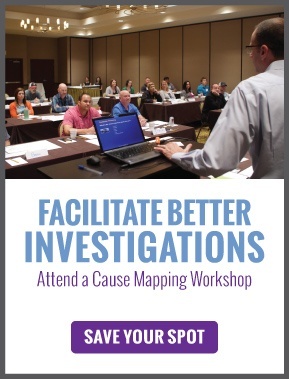What is 5-Why? 5-Why is a problem-solving tool that starts with a problem then asks a series of why questions. The first question is “Why did this happen?” The answer to that question becomes the basis for the second why question which is again, “Why did this happen? This continues for the third, fourth and fifth why questions. The concept of 5-Whys is easy to understand, but how it’s used varies widely. People don’t agree on the format for documenting it, the logic to explain it, how it should be used or the benefits of it.
Interpretations of 5-Why
Some people have a strict definition of 5-Why where the fifth why provides the root cause of the problem. Others believe 5-Why shouldn’t be used at all – the two biggest criticisms being it’s too simple for complex problems and it’s not repeatable. And still others don’t see any benefit of asking why questions to investigate an issue. It’s incredible how much confusion there is with such a simple tool. The three-year-olds around the globe ask Why questions naturally, but multinational corporations struggle with it. We need to understand what 5-Whys is and what it’s not.
The Number 5
First, is there anything special about five why questions? No. The number 5 comes after 4 and before 6 – that’s it. There is no special insight contained within the fifth why. Think of five as simply a reminder that there are multiple parts to a problem. An analysis breaks a problem down into parts, but a problem doesn’t necessarily have only five parts. A problem contains all its parts. The Cause Mapping® method starts with 1-Why, then continues for as many as you need to thoroughly explain the issue. There’s no need to fixate on five. Think of 5-Why as a phase of an investigation, not a complete method. Remember, a journey of a thousand miles begins with the first step. Much like a complete investigation begins with first Why, then continues for as many why questions as needed.
Why Questions
The other element of a 5-Why is the why question. The ability to ask and answer why questions effectively is essential to an organization. Have you noticed when a 3-year-old asks a why question people use because in their reply? The root of the word 'because' is cause. The word because means “caused by.” This is the simple way that why questions identify are cause-and-effect relationships. Organizations should be able to explain the cause-and-effect relationships within their problems. An oil refinery needs to know that heat, fuel and oxygen are causes of a fire. Cause-and-effect is the basis for explaining things – everything. Safety incidents, production losses, equipment failures, project delays and even miscommunications are explained by stitching together cause-and-effect relationships. Even the most complex problem can be broken down into individual cause-and-effect relationships. Understanding how different cause-and-effect relationships connect is how something is clearly explained. This is not complicated, so don’t make it complicated in your company.
Cause Mapping® Approach
So regardless of the complexity, a problem can be broken down into cause-and-effect relationships. An investigation can begin with a 1-Why, then expand to a 3-Why, then 5, then 10 and then 25 or more depending on the issue. The word complex means consisting of multiple parts. Cause-and-effect doesn’t change for the type or magnitude of a problem. Smaller investigations will simply have fewer causes and larger investigations will have more causes. Just like looking at a map online, you can zoom in to see more detail, or zoom out to see less. A street map of a city has five streets, but it doesn’t have only five streets. The city has all the streets. You may draw a street map with only shows five streets because that’s all you need to explain how to get from point A to point B. If you need more detail then show more of the streets. The Cause Mapping method takes the same approach to your problems. Keep the analysis simple at the beginning, then only add as much detail as you need to thoroughly explain the issue. You can start with a 1-Why, then you’ll pass through a 5-Why on your way to as much detail as you need to thoroughly explain the issue to find effective solutions.











